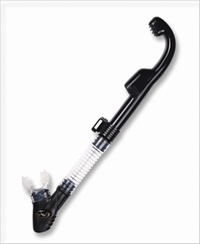
Two of the hardest challenges to overcome during open water training are clearing a flooded mask and no mask breathing. Students with problems generally are used to breathing through their nose and/or their mask doesn`t fit correctly and water constantly gets in.
They make masks with a one way valve in the nose pocket that helps a bit. But you still need to learn to mentally stop breathing through your nose when you inhale through your mouth. Otherwise, anytime you have a little bit of water in the nose pocket, you`ll breath in water and in many cases, freak out and want to bolt to the surface.
If you do get water up your nose, just pinch your nose to avoid getting more in, hold the regulator in your mouth and cough. While still holding your nose, breath for a bit while you calm down and think about what you need to do in order to clear the mask. Whatever you do, don`t bolt to the surface if you can help it...and if you do bolt, remember to always breathe (or exhale slowly if in shallow water) and control your ascent. You don`t want a little water in your mask to be the reason you suffered lung overexpansion or DCS because of a quick ascent rate.
You can practice not breathing through your nose by doing the following: Get just a snorkel and go to a pool or bathtub. With the snorkel in your mouth (without a mask), put your entire face underwater (make sure the end of the snorkel is out of the water) and practice breathing through your mouth while your nose is exposed to the water. You may need to hold your nose at first...but slowly get away from that and get to the point were you can effortlessly breath through the snorkel without getting water in your nose. Make sure to talk long, slow breathes. Practice in cold water if you generally dive in cold water.
I hope this helps the "nose breathers" out there. If you have other suggestions or would like to share your experience with mask clearing or no mask breathing, please write a blog for everyone to read.
by Greg Davis